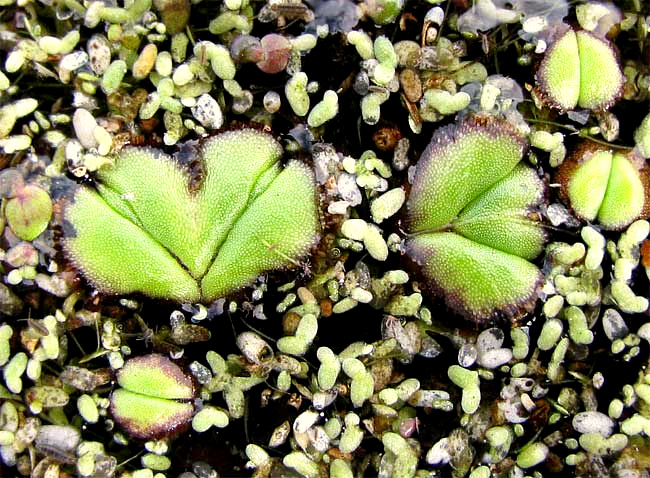Excerpts from Jim Conrad's
Naturalist Newsletter

from the March 2, 2009 Newsletter, issued from the forest near Natchez, Mississippi; elevation ~400ft (120m), ~N31.47°, ~W91.29°:
A FLOATING LIVERWORT
Liverworts are non-flowering, spore-producing plants closely related to mosses. Mostly you see them where mosses are growing, especially moist, shaded boulders and stream banks protected from the wind. At St. Catherine Creek NWR this week I took a close look at some
"green scum" the wind had blown up against a levee and found the unusual aquatic liverwort shown above.
The five largest items in the picture are immature aquatic liverworts, a species sometimes known as the Purple-fringed Riccia. It's RICCIOCARPUS NATANS. The smaller surface-floating plants surrounding the liverworts are duckweed, genus Lemna, probably Lemna minor.
I'd been cued to look at surface-floating aquatics because along the road Refuge signs asked boaters to clean their motors well before leaving because the lake we were next to was contaminated with an aquatic fern, Salvinia, and they didn't want Salvinia to get started elsewhere. I found no Salvia. It looks a bit like our liverwort and I'm halfway wondering if maybe there's been a misidentification, for Salvinia has more of a reputation as an invasive aquatic weed than Ricciocarpus natans. You can see Salvinia's similarity at http://www.agric.wa.gov.au/ikmp/images/salvinia.gif.
Our liverwort's most obvious field marks are its free-floating nature, its flattened body, or thallus, about the size of a thumbnail, and the way the veins in its thallus dichotomously divide -- a vein forks at its tip, then the new vein forks, etc. The thallus's underside bears long, dark brown to purple scales. Spore-producing sporangia sometimes appear along the furrows cutting across the thallus's top, but spores seldom are produced, the plant mostly reproducing by dividing the thallus.
Ducks and other wildlife eat duckweed, so I suppose they also eat Purple-fringed Riccia, though I can't find literature saying so. Most people, if they know about our liverwort at all, it's because aquarists occasionally grow them to provide anchorage for the bubble-nests of such fish as Bettas and Gouramis, and then as protection for the fry.
Though my impression is that Purple-fringed Riccia is seldom if ever common, it shows up here and there across the world.